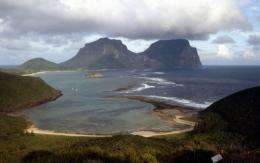Ancient Australian reef raises hopes for coral as seas warm

Australian scientists Thursday said they had discovered a sprawling ancient reef in chilly southern waters which could hold new hope for the future of coral as sea temperatures rise.
Researchers used high-resolution sonar and sophisticated drilling to find the fossil reef near a living coral site at Lord Howe Island, 600 kilometres (400 miles) off southeastern Australia -- the world's southernmost reef.
Around 20 times the size of the modern reef, the fossil site flourished between 9,000 and 7,000 years ago, before perishing, it is thought, due to an abrupt rise in sea levels linked to melting of the Antarctic ice sheet.
Lead researcher Colin Woodroffe said the discovery showed coral had once thrived in the southern waters and might do so again as climate change warms the seas, bleaching and destroying reefs further north.
"As global temperatures warm, the reefs in the tropical areas are increasingly stressed, particularly by coral bleaching, and there's been some suggestions that reefs might be able to expand further towards the poles but not much evidence of that," Woodroffe told AFP.
"Our evidence here is that indeed there was a reef, at this limit, that was much more extensive, and that does look quite promising in terms of the opportunity for the reef to expand again."
Woodroffe, from the University of Wollongong, south of Sydney, said the research showed corals may be able to recolonise south as more tropical habitats became hostile and find "refuge" in reefs usually considered too deep for coral growth.
His team will next take their search 26 kilometres south of Lord Howe Island to Ball's Pyramid, a volcanic remnant that juts spectacularly from the ocean, to see if there was a similar reef there and explore why the fossil reef had perished.
"We'd like to interpret why it is that that reef gave up in the past, (it's) just a hypothesis at this stage that it was the speed of sea-level rise," he said.
"But it may be related to temperature changes in the past as well, that's an alternative hypothesis."
Scientists say corals are vital to marine life because they provide habitats for a vast variety of creatures and absorb large levels of poisonous carbon dioxide.
(c) 2010 AFP















